
 |
|
| Home Technology / Education Events & News Archives Designs e - NewsLetter |
|
Natural Blister from Entombment of a
Pearlfish Within a Pinctada Maxima Shell - Sally Chan & Emiko Yawaza  Figure 1. A natural blister that took the form of a pearlfish on the inner surface of one Pinctada maxima valve.Photo: Jian Xin (Jae) Liao/GIA. Courtesy: ECIJA
Figure 1. A natural blister that took the form of a pearlfish on the inner surface of one Pinctada maxima valve.Photo: Jian Xin (Jae) Liao/GIA. Courtesy: ECIJA
Pearlfish are marine fish of the Carapidae family that live symbiotically inside various invertebrate hosts. Occasionally, the remains of these fishes may be found completely covered by mother-of-pearl on the inner surfaces of some bivalve mollusks (J. Ballard, "The pearlfish," African Wildlife, Vol. 45, No. 1, 1991, pp. 16–19). The New York laboratory recently had the opportunity to examine a unique Pinctada maxima shell with a clear blister that took the form of a fish (figure1). The shell dimensions were approximately 21×19 cm, and the entombed fish measured approximately 10 cm in length. The P. maxima bivalve's soft internal body organs are enclosed and protected by the outer shell that is secreted by the mantle to form the beautiful inner nacreous mother-of-pearl layers and the pearls that are familiar to most (P.C. Southgate and J.S. Lucas, The Pearl Oyster, Elsevier, Oxford, UK, 2008, pp. 57–58). The hard surface of the oyster shell and the nooks within the shells provide places where a host of small animals such as pea crabs, shrimp, and fish can live. Pearl gemologists from GIA in Bangkok observed these within numerous P. maxima mollusks during a 2013 field expedition 80 miles off the coast of Broome, Western Australia. The shape and size of an example recorded from the trip (figure 2) closely resembles the one examined by the lab.  Figure 2. An example of a living pearlfish with a slender, elongated shape and translucent body, found residing
inside a P. maxima shell during a 2013 GIA field expedition to Broome, Australia. Photo: Areeya Manustrong/GIA
Figure 2. An example of a living pearlfish with a slender, elongated shape and translucent body, found residing
inside a P. maxima shell during a 2013 GIA field expedition to Broome, Australia. Photo: Areeya Manustrong/GIA
There is a delicate harmony and balance between the mollusk and fish in their cohabitation. The pearlfish has been known to settle in the oyster shell for shelter and live in symbiosis without either one harming the other (E. Parmentier and P. Vandewalle, "Morphological adaptations of Pearlfish (Carapidae) to their various habitats," in A.L. Val and B.G. Kapoor, Eds., Fish Adaptations, Science Publishers, Enfield, New Hampshire, 2003, pp. 261–276). When the pearlfish eventually dies, the oyster cannot eject the organism and its self-healing mechanism kicks into action. The mollusk begins to deposit layers of nacre over the irritant to ease the likely discomfort experienced. The organism decomposes over time and the skeletal remains are left encased underneath the nacre to form a "blister" (GIA and CIBJO definition) on the inner surface of the shell. The microradiographic images obtained for this sample examined by the New York laboratory show the fish's skeletal remains very clearly (figure 3). This extraordinary specimen is another prime example of Mother Nature's fascinating manifestations and was something out of the ordinary for everyone who handled and examined it in the laboratory.  Figure 3. Microradiographic image of the pearlfish on the shell revealing the preserved details from head to tail beneath the nacre.
Photo: Jian Xin (Jae) Liao/GIA
Figure 3. Microradiographic image of the pearlfish on the shell revealing the preserved details from head to tail beneath the nacre.
Photo: Jian Xin (Jae) Liao/GIA
|